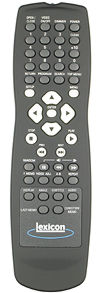Lexicon RT-10 Universal Disc Player Page 2
 The more time I spent with the Lexicon RT-10, the more I came to value its video adjustments. Unlike Toshiba DVD players, which force the user to go through multiple onscreen menus chockablock with cryptic pictographs, the RT-10's controls are easy to access and simply labeled, permitting me to make adjustments quickly and effectively. All but the most horrendous DVDs can benefit from a bit of judicious tweaking; with the RT-10, this tweaking can be accomplished with minimum muss and fuss.
The more time I spent with the Lexicon RT-10, the more I came to value its video adjustments. Unlike Toshiba DVD players, which force the user to go through multiple onscreen menus chockablock with cryptic pictographs, the RT-10's controls are easy to access and simply labeled, permitting me to make adjustments quickly and effectively. All but the most horrendous DVDs can benefit from a bit of judicious tweaking; with the RT-10, this tweaking can be accomplished with minimum muss and fuss.
Audio Performance
With three digital outputs in addition to its one 2-channel and one 5.1-channel analog outputs, the Lexicon RT-10 can be hooked up to an A/V processor in a variety of ingenious ways. I used three of the Lexicon MC-12 preamp-processor's inputs. The DVD-1 input got the coaxial digital feed, DVD-2 received 5.1 analog, and CD got the AES/EBU PCM digital connection. I set up DVD-1 for DVD-Vs, DVD-2 for SACDs and DVD-As, and CD for CDs or MP3s. DVD-1 and DVD-2 could also play CDs, but for the best CD sound, using the RT-10's AES/EBU digital output is the way to go. In direct A/B comparisons with the coax output, the RT-10's AES/EBU output had slightly better detail, bass clarity, and re-creation of depth.
When I reviewed the Marantz SA-12S1 multichannel SACD/DVD player (SGHT, July/ August 2002), I was disappointed by its CD performance from the built-in analog outputs. I had no such complaints about the Lexicon. Although the RT-10's D/A converters are not quite the equal of those in the Lexicon MC-12, the RT-10 came close enough to make any differences subtle. Only on minimally miked classical recordings did I hear the MC-12's superior upper-frequency air and re-creation of depth. On multimiked pop recordings, the MC-12's slight sonic advantage was practically nonexistent.
Compared with my reference CD transport, the C.E.C. TL 2, the RT-10 fared remarkably well. Both players have AES/EBU outputs, so my A/B comparisons were on a level field. The C.E.C. has a more tubelike character, with slightly greater depth, a more relaxed and liquid midrange, and a larger but softer low bass. The RT-10 had a more matter-of-fact midrange presentation, better transient response, superior rhythmic pace, and tighter, better-defined low bass.
With pop recordings, I preferred the Lexicon's superior control of complex dynamic transients and intricate mixes. With chamber music and small-group jazz, the C.E.C.'s more euphonic presentation, relaxed midrange, and better dimensional re-creation made music more intimate and involving. Which machine was tops? The answer will depend on your musical tastes and sonic preferences.
Playing SACDs, the RT-10 sounded superb. Until you've heard Glenn Gould's 1981 performance of J.S. Bach's Goldberg Variations (Sony Classical SS 37779), you haven't heard how realistic a 2-channel SACD can sound. Donald Runnicles and the Atlanta Symphony Orchestra's recording of Orff's Carmina Burana (Telarc SACD-60575) ranks among the best multichannel classical discs I've heard. Through the RT-10, I was instantly transported to the best seat in the hall. The SACD version of Bob Dylan's "Tangled Up in Blue," from a promotional SACD sampler (much of Dylan's back catalog has just been released on SACD), is nothing short of mesmerizing.
My only complaint about the RT-10's SACD reproduction concerns the lack of control over speaker distance settings. Although you can adjust these distances when you initially set up the machine, the settings have no effect on SACDs. If your rear speakers are closer to your listening position than your front speakers, surround information may be too prominent, and ambient sound will reach your ears too soon. To fully enjoy multichannel SACDs, you must position all of your speakers equidistant from your listening seat.
With DVD-Audio discs, the distance settings worked just fine but the speaker size settings had no effect. This may be an issue if your speakers are minimonitors of limited frequency range, but it wasn't a problem in my system—the RT-10 did as fine a job with DVD-As as with SACDs. The DVD-A of Pat Leonard's new multichannel mix of Toy Matinee (DTS Entertainment 69286-01030-9-2) maximizes the album's already substantial theatrical power and emotional impact. Béla Fleck's The Bluegrass Sessions: Tales from the Acoustic Planet Volume 2 (Warner Bros. 47332-9) also benefits from surround treatment. The miking orientation puts you in the center of a super jam circle.
Perhaps it's not quite fair to compare the DVD-A performance of Lexicon's RT-10 and MC-12 with that of Meridian's 598 player and 568.2 pre-pro. The Meridian duo includes a proprietary digital connection for DVD-As so that all of the processor's sophisticated speaker controls—including size, distance, phase, and bass management—can be applied; the Lexicon RT-10 can pass along only its analog output to the MC-12.
The Meridian system produced a less mechanical, more natural sound from DVD-As, with greater dynamic ease and better inner detail. CDs through the Meridian system were slightly more euphonic, with an overall sound reminiscent of that of the C.E.C. TL 2 transport. Both systems had excellent low-level detail, dimensional palpability, and dynamic agility, and either should make even your oldest CDs sound better than you might expect. The only black marks against the Meridian system are that it doesn't play SACDs and costs about $16,000 (with the Meridian 562V video controller), vs. the Lexicon combo's price of $13,500, including SACD playback.
It was impossible to fault the RT-10's audio performance from DVD-Video discs. No matter what sort of soundtrack, from the faintest Foley effects in Monsters, Inc. to walls of angry water in Blue Crush, the Lexicon delivered whatever a disc dished out. I preferred the sound from its coaxial digital connection to its analog 5.1 outputs because of the more precise options in surround sound, crossovers, and bass management available through the MC-12. But aside from their more limited adjustments, the RT-10's built-in analog outputs had no serious flaws.
Conclusion
Unlike most home theater manufacturers, Lexicon has a long history of making products for professional musicians and recording engineers. This has given them a different take on home-theater gear. In the pro market, ergonomic elegance and day-to-day reliability must go hand in hand with sonic excellence, and the RT-10 is a shining example of these unique corporate values. Coupled with Lexicon's MC-12 pre-pro, the RT-10 operated in a simple, transparent manner that made it easy to enjoy any movie or music disc, regardless of its format, in stellar audio and video quality. The RT-10 sets a high standard for what videophiles should expect from a high-end universal disc player. I simply love this thing. I dare you to find a better universal player for less than $3500.
- Log in or register to post comments









































